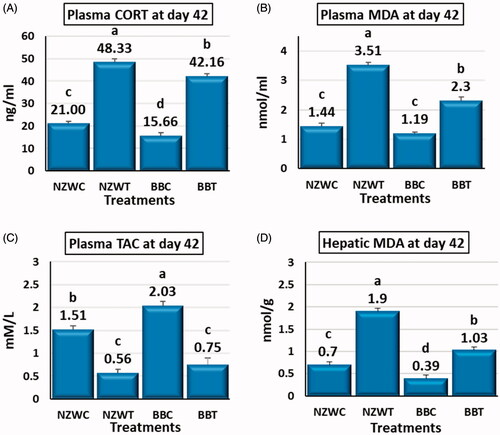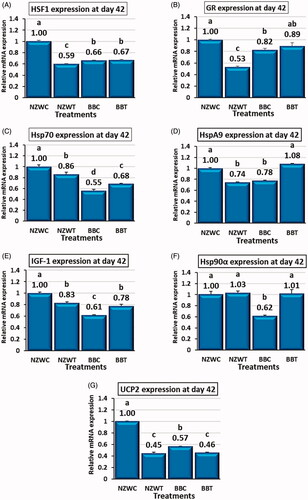Figures & data
Table 1. A list of the primer’s sequences, annealing temperature, and amplicon size which used in the present study.
Figure 1. Effect of early age short-term thermal stress (36 ± 1ºC for 6 h) at day 42 of age on plasma corticosterone CORT (A), plasma malondialdehyde (MDA) (B), plasma plasma total antioxidant capacity (TAC) (C) and hepatic malondialdehyde (MDA) (D) of NZW and BB rabbits. The four groups (n = 6 rabbit/group) include New Zealand white control (NZWC), New Zealand white treated (NZWT), Baladi Black Control (BBC), and Baladi Black treated (BBT). Different lower-case letters above the bars indicate significant differences (p < .05) among groups.

Figure 2. Effect of early age short-term thermal stress at day 42 of age on plasma corticosterone (CORT) (A), plasma malondialdehyde (MDA) (B), plasma total antioxidant capacity (TAC) (C) and hepatic malondialdehyde (MDA) (D) of NZW and BB rabbits which re-exposed to acute heat stress (36±1° C for six hours) at 13 weeks of age. All the early (42 days of age) heat-stressed (NZWT and BBT) and unstressed (NZWC and BBC) groups were exposed to acute heat stress (36±1° C for six hours) at 13 weeks of age. Upon the acute heat stress at week 13 of age, NZWC, NZWT, BBC and BBT groups were renamed as New Zealand white control exposed (NZWC2), New Zealand white treated (NZWT2), Baladi Black Control exposed (BBC2) and Baladi Black treated (BBT2), respectively. Different lower-case letters above the bars indicate significant differences (p < 0.05) among groups.

Figure 3. Effect of early age short-term thermal stress (36 ± 1ºC for 6 h) at day 42 of age on mRNA expression : heat shock transcription factor 1 (HSF1) (A), glucocorticoid receptor (GR) (B), heat shock 70kDa protein 2 (Hsp70) (C), heat shock protein family A (Hsp70) member 9 (HspA9) (D), Insulin-like growth factors-1 (IGF-1) (E), heat shock protein 90 alpha family class A member 1 (Hsp90α) (F) and Uncoupling proteins 2 (UCP2) (G) genes in the liver of NZW and BB rabbits. The four groups (n = 6 rabbit/group) include New Zealand white control (NZWC), New Zealand white treated (NZWT), Baladi Black Control (BBC), and Baladi Black treated (BBT). Different lower-case letters above the bars indicate significant differences (p < .05) among groups.

Figure 4. Effect of early age short-term thermal stress at day 42 of age on mRNA expression heat shock transcription factor 1 (HSF1) (A), glucocorticoid receptor (GR) (B), heat shock 70kDa protein 2 (Hsp70) (C), heat shock protein family A (Hsp70) member 9 (HspA9) (D), Insulin-like growth factors-1 (IGF-1) (E), heat shock protein 90 alpha family class A member 1 (Hsp90α) (F) and Uncoupling proteins 2 (UCP2) (G) genes in the liver of NZW and BB rabbits which re-exposed to acute heat stress (36±1° C for six hours) at 13 weeks of age. All the early (42 days of age) heat-stressed (NZWT and BBT) and unstressed (NZWC and BBC) groups were exposed to acute heat stress (36±1° C for six hours) at 13 weeks of age. Upon the acute heat stress at week 13 of age, NZWC, NZWT, BBC and BBT groups were renamed as New Zealand white control exposed (NZWC2), New Zealand white treated (NZWT2), Baladi Black Control exposed (BBC2) and Baladi Black treated (BBT2), respectively. Different lower-case letters above the bars indicate significant difference (p < 0.05) among groups.

